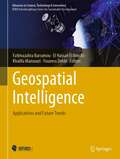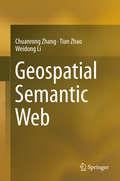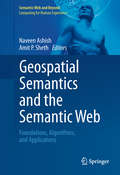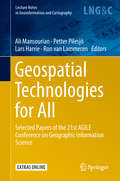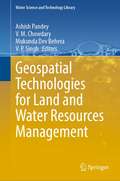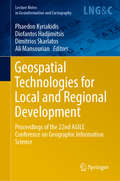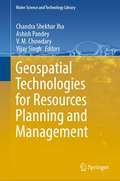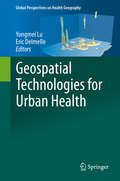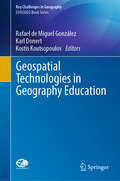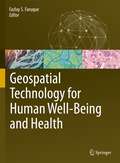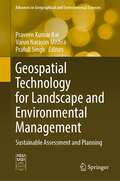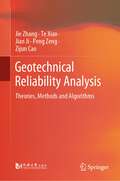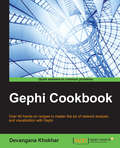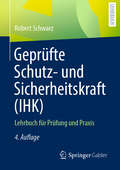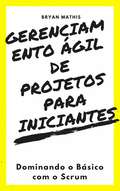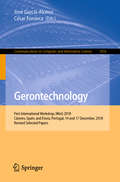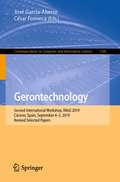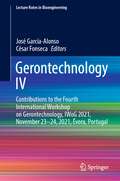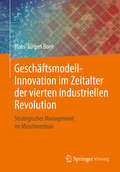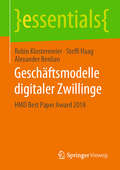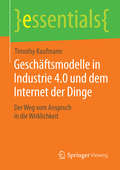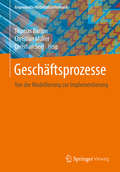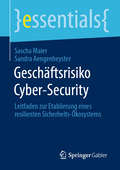- Table View
- List View
Geospatial Intelligence: Applications and Future Trends (Advances in Science, Technology & Innovation)
by Fatimazahra Barramou El Hassan El Brirchi Khalifa Mansouri Youness DehbiThis book explores cutting-edge methods combining geospatial technologies and artificial intelligence related to several fields such as smart farming, urban planning, geology, transportation, and 3D city models. It introduces techniques which range from machine and deep learning to remote sensing for geospatial data analysis.The book consists of two main parts that include 13 chapters contributed by promising authors. The first part deals with the use of artificial intelligence techniques to improve spatial data analysis, whereas the second part focuses on the use of artificial intelligence with remote sensing in various fields. Throughout the chapters, the interest for the use of artificial intelligence is demonstrated for different geospatial technologies such as aerial imagery, drones, Lidar, satellite remote sensing, and more. The work in this book is dedicated to the scientific community interested in the coupling of geospatial technologies and artificial intelligence and exploring the synergetic effects of both fields. It offers practitioners and researchers from academia, the industry and government information, experiences and research results about all aspects of specialized and interdisciplinary fields on geospatial intelligence.
Geospatial Semantic Web
by Chuanrong Zhang Tian Zhao Weidong LiThis book covers key issues related to Geospatial Semantic Web, including geospatial web services for spatial data interoperability; geospatial ontology for semantic interoperability; ontology creation, sharing, and integration; querying knowledge and information from heterogeneous data source; interfaces for Geospatial Semantic Web, VGI (Volunteered Geographic Information) and Geospatial Semantic Web; challenges of Geospatial Semantic Web; and development of Geospatial Semantic Web applications. This book also describes state-of-the-art technologies that attempt to solve these problems such as WFS, WMS, RDF, OWL and GeoSPARQL and demonstrates how to use the Geospatial Semantic Web technologies to solve practical real-world problems such as spatial data interoperability.
Geospatial Semantics and the Semantic Web
by Naveen Ashish Amit P. ShethThe availability of geographic and geospatial information and services, especially on the open Web has become abundant in the last several years with the proliferation of online maps, geo-coding services, geospatial Web services and geospatially enabled applications. The need for geospatial reasoning has significantly increased in many everyday applications including personal digital assistants, Web search applications, local aware mobile services, specialized systems for emergency response, medical triaging, intelligence analysis and more. Geospatial Semantics and the Semantic Web: Foundations, Algorithms, and Applications, an edited volume contributed by world class leaders in this field, provides recent research in the theme of geospatial semantics. This edited volume presents new information systems applications that have potential for high impact and commercialization. Also, special effort was made by the contributors to focus on geospatial ontology development, related standards, geospatial ontology alignment and integration, and algorithmic techniques for geospatial semantics. Case studies and examples will be provided throughout this book as well as possibilities for future research.
Geospatial Technologies for All: Selected Papers Of The 21st Agile Conference On Geographic Information Science (Lecture Notes in Geoinformation and Cartography)
by Ali Mansourian Petter Pilesjö Lars Harrie Ron Van LammerenThis book presents the research papers accepted for the 21st AGILE Conference on Geographic Information Science, held at Lund University Geographical Information Systems (GIS) Centre, Sweden on 12–15 June 2018. It discusses the role of geospatial technologies in the digitalization of society and is intended primarily for professionals and researchers in fields that can benefit from geoinformation – both within and outside the area of geographic information science.
Geospatial Technologies for Land and Water Resources Management (Water Science and Technology Library #103)
by Ashish Pandey V. M. Chowdary Mukunda Dev Behera V. P. SinghThis book focuses on the application of geospatial technologies to study the land use land cover (LULC) dynamics, agricultural water management, water resources assessment and modeling, and studies on natural disasters. LULC dynamics is one of the major research themes for studying global environmental change using remote sensing data. The section on LULC dynamics covers the multi-variate criteria for land use and land cover classification and change assessment in the mountainous regions. Further, LULC change detection of the Tons river basin and LULC dynamics at decadal frequency are studied to derive adaptation and mitigation strategies. Landscape-level forest disturbance modeling, together with conservation implications, is also included. The watershed management approach is necessary for comprehensive management of land and water resources of any region, where studies on multi-criteria analysis for rainwater harvesting planning and its impact on land use land cover transformations in rain-fed areas using geospatial technologies are presented in this book.The book will be useful for academics, water practitioners, scientists, water managers, environmentalists, and administrators, NGOs, researchers, and students who are actively involved in the application of geospatial technologies in LULC studies, agricultural water management and hydrological modelling and natural disasters for addressing the challenges being posed by climate change while addressing issues of food and water securities
Geospatial Technologies for Local and Regional Development: Proceedings of the 22nd AGILE Conference on Geographic Information Science (Lecture Notes in Geoinformation and Cartography)
by Ali Mansourian Phaedon Kyriakidis Diofantos Hadjimitsis Dimitrios SkarlatosThis book includes the full research papers accepted by the scientific programme committee for the 22nd AGILE Conference on Geographic Information Science, held in June 2019 at Cyprus University of Technology, Limassol, Cyprus. It is intended primarily for professionals and researchers in geographic information science, as well as those in related fields in which geoinformation application plays a significant role.
Geospatial Technologies for Resources Planning and Management (Water Science and Technology Library #115)
by Chandra Shekhar Jha Ashish Pandey V. M. Chowdary Vijay SinghThis book focuses on the application of geospatial technologies for resource planning and management for the key natural resources, e.g. water, agriculture and forest as well as the decision support system (DSS) for infrastructure development. We have seen in the past four decades that the growing complexities of sustainable management of natural resources management have been very challenging. The book has been written to leverage the current geospatial technologies that integrate the remotely sensed data available from various platforms, the precise locational data providing geospatial intelligence, and the advanced integration tools of Geographical Information Systems (GIS). Geospatial technologies have been used for water resources management employing geomorphological characteristics, analysis of river migration pattern, understanding the large-scale hydrological process, wet land classification and monitoring, analysis of glacial lake outburst flood (GLOF), assessment of environmental flow and soil erosion studies, water quality modelling and assessment and rejuvenation of paleochannels through groundwater recharge. Geospatial technologies have been applied for crop classification and mapping, soil moisture determination using RISAT-1 C-band and PALSAR-2 L-band sensors, inventory of horticulture plantations, management of citrus orchards, crop yield forecasting, rice yield estimation, estimation of evapotranspiration and its evaluation against lysimeter and satellite-based evapotranspiration product for India to address the various issues of the agricultural system management. Geospatial technologies have been used for generation of digital elevation model, urban dynamics assessment, mobile GIS application at grass root level planning, cadastral level developmental planning and e-governance applications, system dynamics for sustainable development, micro-level water resources planning, site suitability for sewage treatment plant, traffic density assessment, geographical indications of India, archaeological applications and disasters interventions to elaborate various issues of DSS for infrastructure development and management. Geospatial technologies have been employed for the generation and reconciliation of the notified forest land boundaries, and also the land cover changes analysis within notified forest areas, forest resource assessment, management and monitoring and wildlife conservation and management. This book aims to present high-quality technical case studies representing the recent developments in the “application of geospatial technologies for resource planning and management”. The editors hope that this book will serve as a valuable resource for scientists and researchers to plan and manage land and water resources sustainably.
Geospatial Technologies for Urban Health (Global Perspectives on Health Geography)
by Yongmei Lu Eric DelmelleThis volume presents a timely collection of research papers on the progress, opportunities, and challenges related to the advancement of geospatial technologies for applications in urban health research and management. The chapter authors cover technologies ranging from traditional GIS and remote sensing technologies, to recently developed tracking/locational technologies and volunteered geographic information (VGI). In four main sections, the book uniquely contributes to the conversation of how geospatial technologies and other GIScience research may be enhanced by addressing the data and challenges presented by urban health issues. The book is intended for those with backgrounds in health and medical geography, social epidemiology, urban planning, health management, and lifestyle research. The book starts with an introduction by the editors, providing an overview of traditional and emerging geospatial technologies and how they each can significantly contribute to urban health studies. Section 1 covers urban health risk and disease, and analyses the spatial and temporal patterns of selected urban health issues. Section 2 addresses urban health service access, and demonstrates how traditional and new geospatial technologies apply to different segments of urban populations facing varied challenges. Section 3 focuses on incorporating geospatial technologies in promoting healthy behaviours and lifestyles in urban settings. Section 4 assesses how geospatial technologies may be incorporated into urban health policies and management practices. Adopting a forward-looking perspective, these papers examine the various health challenges in urban systems, and explore how new and emerging geospatial technologies will need to develop to address these problems.
Geospatial Technologies in Geography Education (Key Challenges in Geography)
by Rafael de Miguel González Karl Donert Kostis KoutsopoulosThis book addresses new pedagogies focusing on the use of geospatial technologies and geomedia in the classroom. Today, geospatial technologies are substantially influencing geography teaching and learning, particularly in secondary education. Web-GIS, virtual globes, storytelling, maps and apps for mobile devices are transforming the nature and design of geography curricula, instructional processes, didactics, resources and assessments. Undoubtedly, geography is among those school subjects that have benefited most from the implementation of new technologies in the classroom. Geospatial technologies can be used to develop inquiry-based learning or project-based learning pedagogies and help students to acquire spatial reasoning and spatial citizenship skills in the context of education for sustainable development.This book highlights a range of initiatives, projects and educational practices – from several European countries and settings – related to geospatial challenges in geography education. Given its scope, it will be equally appealing to scientists, students and teachers of geography and other fields using geospatial technologies and geomedia.
Geospatial Technology for Human Well-Being and Health
by Fazlay S. FaruqueOver the last thirty years or so, there have been tremendous advancements in the area of geospatial health; however, somehow, two aspects have not received as much attention as they should have received. These are a) limitations of different spatial analytical tools and b) progress in making geospatial environmental exposure data available for advanced health science research and for medical practice. This edited volume addresses those two less explored areas of geospatial health with augmented discussions on the theories, methodologies and limitations of contemporary geospatial technologies in a wide range of applications related to human well-being and health. In 20 chapters, readers are presented with an up-to-date assessment of geospatial technologies with an emphasis on understanding general geospatial principles and methodologies that are often overlooked in the research literature. As a result, this book will be of interest to both newcomers and experts in geospatial analysis and will appeal to students and researchers engaged in studying human well-being and health. Chapters are presenting new concepts, new analytical methods and contemporary applications within the framework of geospatial applications in human well-being and health. The topics addressed by the various chapter authors include analytical approaches, newer areas of geospatial health application, introduction to unique resources, geospatial modeling, and environmental pollution assessments for air, water and soil.Although geospatial experts are expected to be the primary readers, this book is designed in such a way so that the public health professionals, environmental health scientists and clinicians also find it useful with or without any familiarity with geospatial analysis.
Geospatial Technology for Landscape and Environmental Management: Sustainable Assessment and Planning (Advances in Geographical and Environmental Sciences)
by Praveen Kumar Rai Varun Narayan Mishra Prafull SinghGeospatial technology is a combination of state-of-the-art remote sensing and technology for geographic information systems (GIS) and global navigation satellite systems (GNSS) for the mapping and monitoring of landscapes and environment. The main thrust of using geospatial technology is to understand the causes, mechanisms, and consequences of spatial heterogeneity, while its ultimate objective is to provide a scientific basis for developing and maintaining ecologically, economically, and socially sustainable landscapes. This book presents new research on the interdisciplinary applications of geospatial technology for identification, assessment, monitoring, and modelling issues related to landscape, natural resources, and environmental management. The book specifically focuses on the creation, collection, storage, processing, modelling, interpretation, display, and dissemination of spatio-temporal data, which help to resolve environmental management issues including ecosystem change, resource utilization, land use management, and environmental pollution. The positive environmental impacts of information technology advancements with regard to global environmental and climate change are also discussed. The book addresses the interests of a wide spectrum of readers who have a common interest in geospatial science, geology, water resource management, database management, planning and policy making, and resource management.
Geotechnical Reliability Analysis: Theories, Methods and Algorithms
by Jie Zhang Te Xiao Jian Ji Peng Zeng Zijun CaoThis textbook systematically introduces the theories, methods, and algorithms for geotechnical reliability analysis. There are a lot of illustrative examples in the textbook such that readers can easily grasp the concepts and theories related to geotechnical reliability analysis. A unique feature of the textbook is that computer codes are also provided through carefully designed examples such that the methods and the algorithms described in the textbook can be easily understood. In addition, the computer codes are flexible and can be conveniently extended to analyze different types of realistic problems with little additional efforts.
Gephi Cookbook
by Devangana KhokharIf you want to learn network analysis and visualization along with graph concepts from scratch, then this book is for you. This is ideal for those of you with little or no understanding of Gephi and this domain, but will also be beneficial for those interested in expanding their knowledge and experience.
Geprüfte Schutz- und Sicherheitskraft (IHK): Lehrbuch für Prüfung und Praxis
by Robert SchwarzDas vorliegende Lehrbuch richtet sich an alle, die die Prüfung zur Schutz- und Sicherheitskraft vor einer Industrie- und Handelskammer ablegen wollen, und eignet sich zugleich als Nachschlagewerk für die Praxis sowie zur regelmäßigen Weiterbildung. Die aktualisierte 4. Auflage wurde dem aktuellen Rechtsstand im Frühjahr 2020 angepasst, insbesondere wurden die aktuellen Bestimmungen im Gewerberecht - GewO und BewachV - eingearbeitet. Das Werk behandelt systematisch alle prüfungsrelevanten Fachgebiete. Besonderen Wert hat der Autor auf den oft als schwierig empfundenen Rechtsteil gelegt: Zahlreiche Abbildungen und Beispiele veranschaulichen die Inhalte und ihre Bedeutung für die Praxis, erleichtern das Stoffverständnis und das Lernen: Die ideale Prüfungsvorbereitung - Schritt für Schritt.
Geprüfte Schutz- und Sicherheitskraft (IHK): Lehrbuch für Prüfung und Praxis
by Robert SchwarzDas vorliegende Lehrbuch richtet sich an alle, die die Prüfung zur Schutz- und Sicherheitskraft vor einer Industrie- und Handelskammer ablegen wollen, und eignet sich zugleich als Nachschlagewerk für die Praxis sowie zur regelmäßigen Weiterbildung. Die gründlich durchgesehene und verbesserte 5. Auflage entspricht dem aktuellen Rechtsstand 2020/2021 und berücksichtigt auch die Bestimmungen im Gewerberecht – GewO und BewachV. Das Werk behandelt systematisch alle prüfungsrelevanten Fachgebiete. Besonderen Wert hat der Autor auf den oft als schwierig empfundenen Rechtsteil gelegt: Zahlreiche Abbildungen und Beispiele veranschaulichen die Inhalte und ihre Bedeutung für die Praxis, erleichtern das Stoffverständnis und das Lernen: Die ideale Prüfungsvorbereitung – Schritt für Schritt.
Geprüfte Schutz- und Sicherheitskraft (IHK): Lehrbuch für Prüfung und Praxis
by Robert SchwarzDas vorliegende Lehrbuch richtet sich an alle, die die Prüfung zur Schutz- und Sicherheitskraft vor einer Industrie- und Handelskammer ablegen wollen, und eignet sich zugleich als Nachschlagewerk für die Praxis sowie zur regelmäßigen Weiterbildung. Die überarbeitete 6. Auflage entspricht dem aktuellen Rahmenstoffplan vom Mai 2021 und behandelt systematisch alle prüfungsrelevanten Fachgebiete. Besonderen Wert hat der Autor auf den oft als schwierig empfundenen Rechtsteil gelegt: Zahlreiche Abbildungen und Beispiele veranschaulichen die Inhalte und ihre Bedeutung für die Praxis, erleichtern das Stoffverständnis und das Lernen: Die ideale Prüfungsvorbereitung – Schritt für Schritt.
Gerenciamento Ágil de Projetos Para Iniciantes: Dominando o Básico com o Scrum
by Moisés de Jesus Paulo Mavaringana Bryan MathisA abordagem Ágil ao gerenciamento de projetos está ganhando popularidade porque obtém melhores resultados em menos tempo com equipas menores do que os métodos antigos, rígidos e orientados a planos. Na atual economia baseada em informações, na qual a Internet impulsiona novos produtos e exigências dos clientes, o Ágil ajuda as empresas a acompanhar as demandas dos clientes, recebendo mudanças rápidas como parte vital do processo de desenvolvimento. Escrito para iniciantes, este livro explica os conceitos Ágil usando a abordagem Scrum e os encaixa em uma estrutura coesa. Em vez de simplesmente definir termos, ele apresenta o Ágil como um sistema dinâmico e vivo para despir os detalhes e voltar ao básico enquanto gerência projetos. A primeira metade do livro explica o Manifesto Ágil em detalhes, tanto na teoria quanto na prática. A segunda metade do livro fornece explicações detalhadas para a aplicação do Scrum, que é um método ágil conhecido por sua simplicidade e facilidade de implementação. Pequenas startups e empreendedores encontrarão conselhos práticos, encorajamento e inspiração neste livro, enquanto as equipas de desenvolvimento em empresas maiores apreciarão sua explicação clara e concisa de como as peças do quebra-cabeça Ágil se encaixam.
Gerontechnology: First International Workshop, IWoG 2018, Cáceres, Spain, and Évora, Portugal, 14 and 17 December, 2018, Revised Selected Papers (Communications in Computer and Information Science #1016)
by José García-Alonso César FonsecaThis book constitutes the thoroughly refereed post-conference proceedings of the First International Workshop on Gerotechnology, IWoG 2018, held in Cáceres, Spain on December 14, 2018, and in Évora, Portugal, on December 17, 2018. The 24 revised full papers along with 8 short papers presented were carefully reviewed and selected from 71 submissions.The papers are organized in topical sections on knowledge management for health: context, cognition, behavior and user modeling; technologies to increase the quality of life of the elderly population; Internet of Things (IoT); smarts technologies and algorithms for health; monitoring and management of chronic and non-chronic diseases;solutions for active aging, social integration and self-care; health interventions to support caregivers of elderly people; public health initiatives.
Gerontechnology: Second International Workshop, IWoG 2019, Cáceres, Spain, September 4–5, 2019, Revised Selected Papers (Communications in Computer and Information Science #1185)
by José García-Alonso César FonsecaThis book constitutes the thoroughly refereed post-conference proceedings of the Second International Workshop on Gerotechnology, IWoG 2019, held in Cáceres, Spain, in September 2019. The 24 revised full papers along with 11 short papers presented were carefully reviewed and selected from 77 submissions. The papers are organized in topical sections on smart technologies and algorithms for health; technologies to increase the quality of life of the elderly population;Internet of Things (IoT); solutions for active aging, social integration and self-care; monitoring and management of chronic and non-chronic diseases; health interventions to support caregivers of elderly people; public and other health initiatives.
Gerontechnology IV: Contributions to the Fourth International Workshop on Gerontechnology, IWoG 2021, November 23–24, 2021, Évora, Portugal (Lecture Notes in Bioengineering)
by José García-Alonso César FonsecaThis book gathers peer-review contributions to the 4th International Workshop on Gerontechnology, IWoG 2021, held on November 23-24, 2021, in Évora, Portugal. They report on cutting-edge technologies and optimized workflows for promoting active aging and assisting elderly people at home, as well as in healthcare centers. They discuss the main challenges in the development, use and delivery of health care services and technologies. Not only they propose solutions for improving in practice the monitoring and management of health parameters and age-related diseases, yet they also describe improved approaches for helping seniors in their daily tasks and facilitating their communication and integration with assistive technologies, thus improving their quality of life, as well as their social integration. All in all, this book provides health professionals, researchers, and service providers with extensive information on the latest trends in the development and practical application of gerontechnology, with a special emphasis on improving quality of life of the elderly.
Geschäftsmodell-Innovation im Zeitalter der vierten industriellen Revolution: Strategisches Management im Maschinenbau
by Hans-Jürgen BornDas Buch untersucht, inwieweit das Potenzial der vierten industriellen Revolution für den Maschinen- und Anlagenbau maximal genutzt werden kann, um neue, innovative Geschäftsmodelle zu entwickeln. Im Kapitel der evolutionären Geschäftsmodelle wird davon ausgegangen, dass die Weiterentwicklung des Standes der Technik im Maschinen- und Anlagenbau in evolutionärer Weise kontinuierlich erfolgt. Im zweiten Teil des Buches werden Möglichkeiten für disruptive Geschäftsmodelle untersucht. Es wird davon ausgegangen, dass sich auf Grund der technologischen Möglichkeiten die Branchenentwicklung des Maschinen- und Anlagenbaus radikal verändern wird und proprietäre Konzepte aufgebrochen werden und sich offene Konzepte, welche disruptive Wirkung entfalten, entwickeln werden.
Geschäftsmodelle digitaler Zwillinge: HMD Best Paper Award 2018 (essentials)
by Robin Klostermeier Steffi Haag Alexander BenlianDer digitale Zwilling lässt sich als intelligentes, digitales Abbild eines realen Produktes oder Prozesses beschreiben. Die Studie untersucht digitale Zwillinge aus einer Geschäftsmodellperspektive. Eine vergleichende Analyse von sechs unterschiedlichen Geschäftsmodellen anhand des Business Model Canvas zeigt deutliche Unterschiede in der Interpretation der Begrifflichkeit des digitalen Zwillings und dessen Verwendung als Geschäftsmodell auf. Die größte Herausforderung für die Entwicklung digitaler Zwillinge sind fehlende monetäre Argumente und das Überwinden von Schnittstellenproblematiken. Gleichzeitig werden große Potenziale im Business to Business-Bereich (B2B) und mittelfristig auch im Business to Customer-Bereich (B2C) erwartet. Die Autoren:Robin Klostermeier ist Unternehmensberater und berät Kunden zu Fragen der digitalen Transformation und Datenintegration.Prof. Dr. Steffi Haag ist Juniorprofessorin für Wirtschaftsinformatik an der Friedrich-Alexander-Universität Erlangen-Nürnberg. Prof. Dr. Alexander Benlian ist Professor für Wirtschaftsinformatik & E-Services an der Technischen Universität Darmstadt.
Geschäftsmodelle in Industrie 4.0 und dem Internet der Dinge: Der Weg vom Anspruch in die Wirklichkeit (essentials)
by Timothy KaufmannTimothy Kaufmann beschreibt verschiedene Geschäftsmodelle, Kundenbeispiele und geeignete Werkzeuge für die Umsetzung von Industrie 4. 0 und dem Internet der Dinge, die schon heute große Chancen für neue Geschäftsmodelle und die Optimierung von bestehenden bieten. Das vorliegende Essential soll Sie ermutigen, sich jetzt auf den Weg zu begeben!
Geschäftsprozesse
by Thomas Barton Christian Müller Christian SeelDas Buch vermittelt Konzepte, zeigt aktuelle Trends wie agile Methoden, stellt Anwendungsszenarien für die Modellierung und Implementierung von Geschäftsprozessen im Zeitalter der Digitalisierung vor. Das Herausgeberwerk basiert dabei auf Fragestellungen aus der unternehmerischen Praxis. Schwerpunkte sind innovative Analysemethoden, kontextsensitive und wissensintensive Geschäftsprozesse sowie aktuelle Ansätze bei der Umsetzung. Fallstudien runden das Buch ab. Es wendet sich sowohl an Berater und Projektverantwortliche als auch an Studierende und Lehrende.
Geschäftsrisiko Cyber-Security: Leitfaden zur Etablierung eines resilienten Sicherheits-Ökosystems (essentials)
by Sascha Maier Sandra AengenheysterNicht erst seit Corona warnen Beobachter und Behörden vor einem zu erwartenden rasanten Anstieg von Cyberkriminalität im privaten sowie beruflichen Umfeld. Die Digitalisierung von Geschäftsmodellen, intensivere Vernetzung von Prozessen, Produkten und Geräten und die zuletzt stärkere Nutzung von Netzwerken und Geräten im Homeoffice sind die Treiber im Kampf für mehr IT-Sicherheit. Das essential wendet sich insbesondere an Geschäftsführer von kleinen und mittelständischen Unternehmen, für die der Aufbau einer wirksamen und nachhaltigen Cyber-Security mit hohem Aufwand verbunden ist. Das Buch ermöglicht ein grundlegendes Verständnis zu potenziellen Bedrohungen der Cyber-Security sowie den Auswirkungen und bietet einen Leitfaden für die Entwicklung eines resilienten Sicherheits-Ökosystems.
